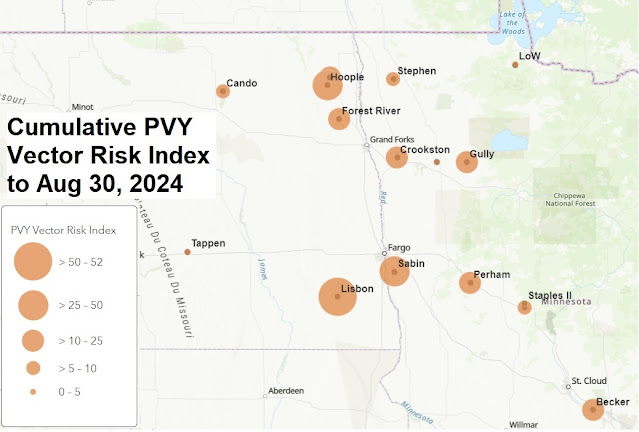Trap Catches July 19 - July 26, 2024.
With 16 traps reporting, regional aphid vector numbers are still very similar to those of last year. Aphid vector numbers more than doubled again this week and the regional PVY Vector Risk Index value doubled as well for the second week in a row. Numbers continue to be tracking up at this point and are fitting our annual average pattern.
No new reports of green peach occurred this week. However, soybean aphids appear to be moving a significant increase in captures this week. In addition, numbers of English grain, corn leaf, and cotton/melon aphids were all up, as well as a number of other species, including non-vector species. Warmer summer conditions have resulted in the development of winged aphids, and the maturing crops are moving them to alternate food sources..
Those warmer temperatures are also going to shorten developmental cycles of wingless aphid colonies already established on crops. Increasing colony size puts additional stress on their host plants, which can lower the plants nutritional value to the aphids. This also is a cue for the development of generations of winged aphids. Given our average seasonal patterns of increasing temperatures through July and into August, it is hardly surprising we see our largest growth of aphid populations during this period (see the graph of the average seasonal aphid vector captures below).
We expect aphid vector numbers will continue to rise over the next few weeks. As stated last week, proactive measures, such as the use of crop oils, are recommended at this time if not already started. The use of the insecticides Fulfill (active ingredient = pymetrozine) and Beleaf (active ingredient = flonicamid) have been shown to decrease the spread of PVY and also to be beneficial when use in conjunction with crop oils such as Aphoil or JMS Stylet oil.
Bottom line, aphid numbers are still increasing rapidly and are expected to continue over the next few weeks. So... Keep on scouting!
Average Regional Total Vector Capture and PVY Vector Risk Index by Week 2012-2022
Scouting for aphids in potatoes:
- Select leaves from the lower to mid canopy. Start at the edge of the field.
- Lower, older leaves will have more established colonies and aphids prefer the balance of nutrients found here; aphids are rarely found on leaves in the upper canopy.
- Avoid leaves on the ground or in contact with the soil.
- In seed potatoes there is only a threshold for PLRV (10 aphids/100 leaves), reactive application of insecticides an effective control for PVY.
- The use of feeding suppressing insecticides, such as pymetrozine (Fulfill®) or flonicamid (Beleaf®) and refined crop oils, such as Aphoil and JMS Stylet Oil, at or prior to field colonization by aphids may reduce the transmission of PVY within fields. Some other insecticides, such as clothianidin (Belay®), imidacloprid (Admire Pro® or Provado®), and spirotetramat (Movento®), have also been demonstrated to reduce the transmission of PVY.
- In table stock potatoes, a treatment threshold of 30 aphids /100 leaves should deter yield loss due to aphid feeding.
The PVY Risk Index Index
Not all species of aphid are equally efficient at transmitting PVY, some are better than others (green peach being the most efficient vector of PVY). So, the total number of aphids in a trap don't necessarily reflect just how much vector pressure there is at that location. The PVY Vector Risk Index compares aphid numbers, incorporating their relative vector efficiency compared to the Queen of PVY vectors (green peach aphid!). Using averaged reference comparisons from the literature, we multiply the number of each aphid species captured by its efficiency compared to Green Peach Aphid to more accurately depict risk posed by the species being trapped. We then sum the totals. The PVY-VRI values are presented on the tables below but also on maps comparing current cumulative risk to the total risk from the sample sites of last year (to compare with your local winter grow out results).
Scouting for aphids in potatoes:
- Select leaves from the lower to mid canopy. Start at the edge of the field.
- Lower, older leaves will have more established colonies and aphids prefer the balance of nutrients found here; aphids are rarely found on leaves in the upper canopy.
- Avoid leaves on the ground or in contact with the soil.
- In seed potatoes there is only a threshold for PLRV (10 aphids/100 leaves), reactive application of insecticides an effective control for PVY.
- The use of feeding suppressing insecticides, such as pymetrozine (Fulfill®) or flonicamid (Beleaf®) and refined crop oils, such as Aphoil and JMS Stylet Oil, at or prior to field colonization by aphids may reduce the transmission of PVY within fields. Some other insecticides, such as clothianidin (Belay®), imidacloprid (Admire Pro® or Provado®), and spirotetramat (Movento®), have also been demonstrated to reduce the transmission of PVY.
- In table stock potatoes, a treatment threshold of 30 aphids /100 leaves should deter yield loss due to aphid feeding.
Click on any image below for full-scale version.
Cumulative PVY Vector Risk Index to 7/26/2024
Cumulative PVY Vector Risk Index to 7/28/2023 for Comparison
Aphid Species Capture and PVY Vector Risk Index for the week ending 7/26/2024

Cumulative Aphid Species Capture and PVY Vector Risk Index to 7/26/24





































